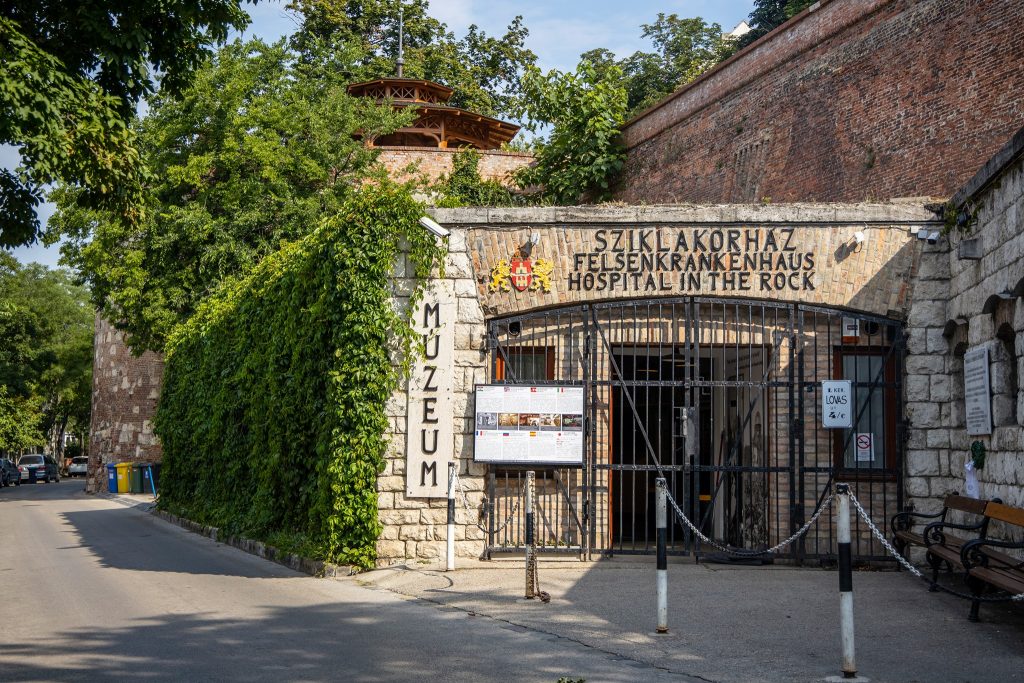Most visitors to Budapest are unaware that beneath the historic Buda Castle lies the Hospital in the Rock Nuclear Bunker Museum. You can explore a remarkable underground complex originally designed as a secret emergency hospital during World War II and later transformed into a nuclear bunker. When you visit, you’ll uncover the extraordinary history of medical care during air raids and the Cold War era, gaining insight into how doctors and nurses prepared for extreme conditions. This museum offers a unique perspective on Budapest’s wartime resilience and civil defense efforts hidden beneath the city’s surface.
The Historic Roots of the Hospital
You can trace the origins of the Hospital in the Rock back to the natural cave systems beneath Castle Hill. These caves offered a strategic location that, prior to World War II, was reinforced specifically to protect civilians during air raids. What began as a protective measure evolved into a fully fledged underground hospital designed to provide urgent medical care amid the chaos of wartime Budapest.
Development Before World War II
Before the war erupted, the intricate 10-kilometer network of caves under Castle Hill was strengthened and adapted for shelter purposes. Reinforcements included structural improvements to withstand bomb blasts, laying the groundwork that would soon support medical facilities underground. This early development ensured the caves could serve multiple civil defense needs, marrying natural protection with man-made resilience.
The Hospital’s Role During WWII
Opening in February 1944, the Hospital in the Rock operated as a critical emergency care unit for civilians and soldiers injured during frequent air attacks. Under Dr. István Kovács’s leadership and staffed by about 40 rotating doctors alongside Red Cross volunteer nurses, the facility vastly exceeded its designed 120-patient capacity, treating up to 700 people during Budapest’s siege.

Detailed accounts reveal how the hospital became a lifeline during intense bombardments. Despite its original design limited to 120 patients, eyewitnesses report caring for nearly six times that number, demonstrating not only the demand but also the staff’s dedication. Noble family members participated as nurses, reflecting how the hospital united people of different backgrounds. Operating continuously until mid-1945, it remained a beacon of hope amid wartime adversity.
The Transformation into a Nuclear Bunker
Between 1958 and 1962, the Hospital in the Rock underwent a significant transformation to meet Cold War demands. Expanding from its WWII medical roots, the facility was reinforced with thick concrete walls, air filtration systems, and independent power supplies, allowing it to function amid nuclear fallout. This shift meant you would find a hospital prepared not only for conventional injuries but also equipped to handle radiation sickness and chemical contamination, making it a frontline defense in civil protection during uncertain times.
Expansion and Reinforcement in the Late 1950s
The extensive renovation included excavating additional chambers and installing heavy blast doors designed to withstand nuclear shockwaves. Reinforcements integrated new water purification technology and sealed ventilation shafts to filter out poison gases. By extending the cave’s usable space, the hospital’s capacity and self-sufficiency dramatically increased, enabling treatment for a much larger number of patients under prolonged siege conditions, unlike its original WWII design.
Training Healthcare Professionals for Nuclear Scenarios
Doctors and nurses assigned to the bunker engaged in rigorous civil defense drills that simulated chemical and nuclear attack conditions. Training involved rapid deployment exercises, use of protective gear, and specialized medical procedures targeting radiation injuries. This continuous preparation ensured that medical staff remained ready to deliver critical care in hostile environments, maintaining operational effectiveness even under extreme pressure.
The training regimen extended well into the 1980s, reflecting evolving Cold War threats. Personnel practiced decompression protocols, triage under contamination, and efficient use of scarce medical resources. These exercises often included full-scale simulations involving cooperation with civil defense units, giving you insight into how military and medical responses were coordinated. Such detailed preparation underscored the hospital’s role as a vital link between emergency healthcare and national survival strategies.
Life and Operations Inside the Bunker
Inside the Hospital in the Rock, daily life combined intense medical urgency with the unique challenges of being deep underground. The cramped, dimly lit spaces forced medical staff to adapt quickly, managing everything from emergency surgeries to long-term patient care amid the constant threat of air raids and later nuclear attacks. Equipment was limited but efficiently organized, and the interaction between doctors, nurses, and volunteers created a tightly knit community dedicated to saving lives under extraordinary circumstances.
Daily Activities of Medical Staff
Your typical day involved alternating shifts for about 40 doctors working in rotation, supported by volunteer Red Cross nurses. You would assist in triaging and treating hundreds of injured civilians and soldiers, often with minimal supplies and under stressful conditions. Regular drills prepared you for chemical or nuclear emergencies, maintaining readiness through civil defense exercises that extended well into the Cold War era.
Notable Stories and Experiences of Patients
Patients treated in the bunker ranged from soldiers wounded during the siege of Budapest to civilians caught in nightly bombings, with many recalling how the hospital cared for far more than its original 120-bed capacity. Some survivors spoke of the unexpected warmth and compassion they found deep beneath Castle Hill, where even noble volunteers labored side by side to ease suffering in a stark, subterranean world.
Several eyewitness accounts highlight the hospital’s resilience during the siege, where up to 700 patients were treated simultaneously despite spatial and resource constraints. Families would recount stories of entire neighborhoods brought underground, witnessing heroic efforts by doctors like Dr. István Kovács, who led teams under immense pressure. These experiences reveal not only the physical hardships endured but also a profound human solidarity that emerged amid the chaos.
Opening to the Public: The Museum Era
After decades of secrecy, the Hospital in the Rock’s hidden corridors finally opened to the public in 2008. The transformation from a classified nuclear bunker hospital to a museum has allowed visitors to step back into a vivid piece of Budapest’s wartime and Cold War history. You can explore the preserved medical rooms, original equipment, and underground tunnels while gaining insight into the extraordinary efforts that kept civilians and soldiers alive during turbulent times.
Declassification and Historical Significance
The lifting of the ‘secret’ classification in 2002 marked a turning point, revealing the hospital’s dual role during WWII and the Cold War. You can appreciate how this site served not only as a unique emergency hospital but also as a critical part of Hungary’s civil defense strategy against nuclear and chemical threats. Its preservation offers a rare, tangible link to both wartime resilience and Cold War preparedness.
Visitor Engagement and Popularity Over the Years
Visitor numbers have steadily grown since the museum’s opening, reaching approximately 100,000 annually by 2015. You’ll find its blend of historical authenticity and immersive storytelling appealing, whether you’re interested in medical history, military strategy, or secret Cold War bunkers. Guided tours, engaging exhibits, and its location beneath the iconic Buda Castle make it a unique cultural destination in Budapest.
Beyond the impressive visitor statistics, the museum actively engages its audience by offering specialized tours that delve into different eras of its operation. For example, themed visits spotlight the hospital’s role during the Siege of Budapest or its Cold War nuclear bunker transformation. Interactive displays and firsthand accounts from former medical staff deepen your understanding and connection, turning a visit into a compelling journey through Hungary’s layered past. Educational programs targeted at schools and history enthusiasts further extend the museum’s impact, helping preserve this hidden world for future generations.
A Symbol of Resilience and Innovation
The Hospital in the Rock stands as a remarkable testament to human resilience and technological ingenuity during times of crisis. What began as a reinforced shelter beneath Buda Castle evolved into a fully functioning underground hospital that treated hundreds under siege conditions in 1944-45. Its later conversion into a nuclear bunker between 1958 and 1962 reflects Hungary’s proactive approach to Cold War threats, blending medical care with civil defense innovation. Visiting this site, you witness a layered history of adaptability that bridges war-era urgency with later Cold War preparedness.
Reflections on the Hospital’s Legacy
The legacy of the Hospital in the Rock invites you to consider the immense efforts to provide care amid chaos. Serving up to 700 patients during WWII siege conditions underlines the dedication of its 40 rotating doctors and volunteer nurses. Beyond its wartime role, reopening during the 1956 Hungarian Revolution emphasizes its ongoing significance as a sanctuary and symbol of community resilience under pressure.
The Importance of Preserving Civil Defense History
Preserving sites like the Hospital in the Rock allows you to engage directly with the material culture of civil defense, revealing the lived realities of Cold War anxieties. The museum’s declassification in 2002 and public opening in 2008 offer unique insights into how medical, military, and civil defense functions intersected beneath Budapest’s surface. Encountering these preserved spaces deepens your understanding of national preparedness and the often-overlooked human element behind Cold War defense strategies.
Delving deeper, the preservation of civil defense history manifests not just in physical conservation but in interpreting the complex narratives that shaped it. The Hospital in the Rock exemplifies how medical innovation, volunteerism, and state security intersect within subterranean walls. Exhibits showcasing Cold War-era exercises and hospital operations help you appreciate the continuous training and readiness practiced by medical staff into the 1980s. This nuanced history challenges simplified Cold War narratives by highlighting how everyday professionals maintained vigilance amid geopolitical tensions, making the museum a vital link between past threats and contemporary peace.
Final Words
On the whole, when you visit the Hospital in the Rock Nuclear Bunker Museum beneath Buda Castle, you step into a unique blend of history and resilience. This underground complex offers you a rare glimpse into wartime medical care and Cold War preparedness. Exploring its reinforced caves and rooms, you gain a deeper understanding of the challenges faced during tumultuous times. Your visit not only informs but also honors the dedication of those who worked tirelessly in this extraordinary setting.




